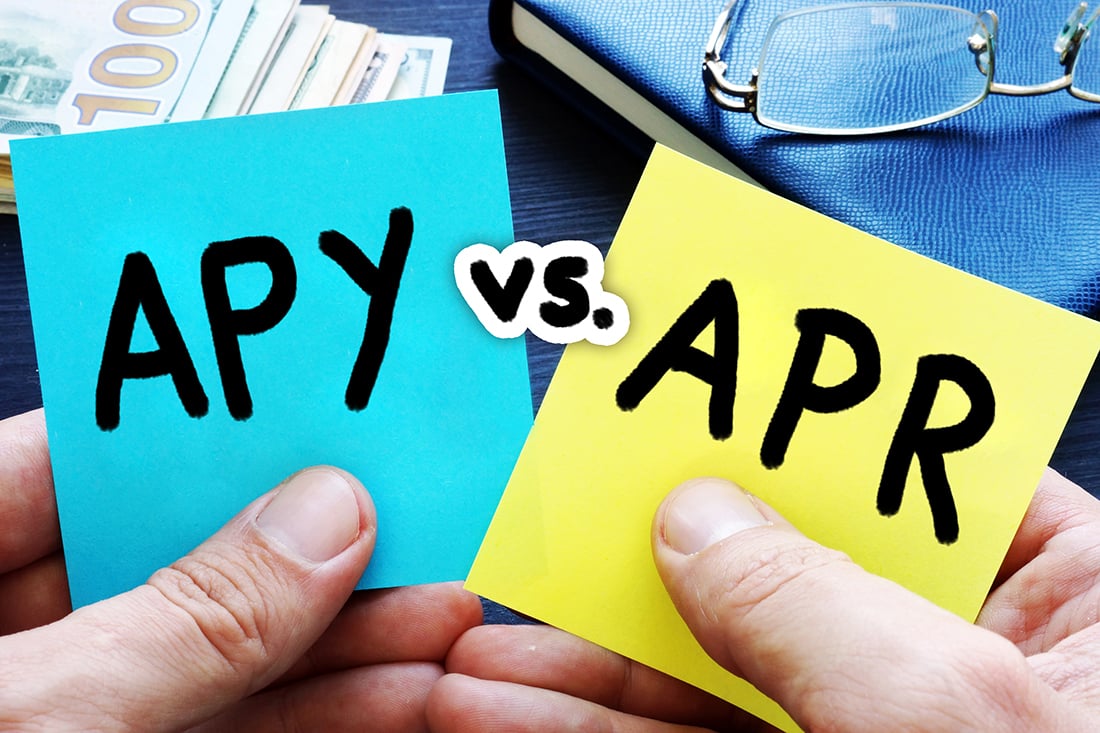
If you ever wondered what the difference is between the APY and the APR, here's all you need to know:
The APY is similar to the annual percentage rate (APR) used for loans. The APR reflects the effective percentage that the borrower will pay over a year in interest and fees for the loan. APY and APR are both standardized measures of interest rates expressed as an annualized percentage rate.
However, APY takes into account compound interest while APR does not. Furthermore, the equation for APY does not incorporate account fees, only compounding periods. That's an important consideration for an investor, who must consider any fees that will be subtracted from an investment's overall return.
How Is APY Calculated?
APY standardizes the rate of return. It does this by stating the real percentage of growth that will be earned in compound interest, assuming that the money is deposited for one year. The formula for calculating APY is:
- APY = (1+r/n)n - 1 {r = period rate; n = number of compounding periods}
For example, if you deposited $100 for one year at 5% interest and your deposit was compounded quarterly, then APY would be (1 + .05/4)4 - 1 = .05095 = 5.095%.
What Is the Difference Between APY and APR?
APY calculates that rate earned in one year if the interest is compounded and a more accurate representation of the actual return rate. For example, accounts that roll over periodically, like certificate of deposits (CD), will have accrued interest added on each period. With each period going forward, the account balance gets a little bigger, so the interest paid on the balance gets bigger as well.
APR includes any fees or additional costs associated with the transaction, but it does not take into account the compounding of interest within a specific year. Rather, it is a simple interest rate that is calculated by multiplying the periodic interest rate by the number of periods in a year in which the periodic rate is applied. It does not indicate how many times the rate is applied to the balance and can be a bit misleading.
KEY TAKEAWAYS
· APR represents the annual rate charged for earning or borrowing money.
· APY takes into account compounding, but APR does not.
· The more frequently the interest compounds, the more significant the difference between APR and APY.
· Investment companies generally advertise the APY, while lenders tout APR.
APR
Financial institutions often tout their credit products using APR since it seems like borrowers end up paying less in the long run for accounts like loans, mortgages, and credit cards.1
APR does not take into account the compounding of interest within a specific year. It is calculated by multiplying the periodic interest rate by the number of periods in a year in which the periodic rate is applied. It does not indicate how many times the rate is applied to the balance. 1
APR is calculated as follows:
APR = Periodic Rate x Number of Periods in a Year
APY
Investment companies generally advertise the APY they pay to attract investors because it seems like they'll earn more on things like certificates of deposit (CDs), individual retirement accounts (IRAs), and savings accounts.
Unlike APR, APY does take into account the frequency with which the interest is applied—the effects of intra-year compounding. This seemingly subtle difference can have important implications for investors and borrowers. APY is calculated by adding 1+ the periodic rate as a decimal and multiplying it by the number of times equal to the number of periods that the rate is applied, then subtracting 1.
The Borrower's Perspective
As a borrower, you are always searching for the lowest possible rate. When looking at the difference between APR and APY, you need to be worried about how a loan might be disguised as having a lower rate. Another term for APY is earned annual interest (EAR), which factors in compounding interest.
When you're shopping around for a mortgage, for instance, you are likely to choose a lender that offers the lowest rate. Although the quoted rates appear low, you could end up paying more for a loan than you originally anticipated.
This is because banks often quote you the annual percentage rate on the loan. But, as we've already said, this figure does not take into account any intra-year compounding of the loan either semi-annually, quarterly, or monthly. The APR is simply the periodic rate of interest multiplied by the number of periods in the year. This may be a little confusing at first, so let's look at an example to solidify the concept.6
The Lender's Perspective
Now, as you may have already guessed, it is not hard to see how standing on the other side of the lending tree can affect your results in an equally significant fashion and how banks and other institutions often entice individuals by quoting APY. Just as those seeking loans want to pay the lowest possible rate of interest, those who are lending money (which is what you're technically doing by depositing funds in a bank) or investing funds want to receive the highest interest rate.
Let's suppose that you are shopping around for a bank to open a savings account. Obviously, you want one that offers the best rate of return on your hard-earned dollars. It is in the bank's best interest to quote you the APY, which includes compounding and will be a sexier number instead of the APR, which doesn't include compounding.
Just make sure you take a hard look at how often that compounding occurs and then compare it to other banks' APY quotes compounding at an equivalent rate. It can significantly affect the amount of interest your savings could accrue.
The Bottom Line
Both APR and APY are important concepts to understand for managing your personal finances. The more frequently the interest compounds, the more significant the difference between APR and APY. Whether you are shopping for a loan, signing up for a credit card, or seeking the highest rate of return on a savings account, be mindful of the different rates quoted. Also, keep in mind that there is a difference between a 360-day year quote and a 365-day year quote:
Here are the key differences in the actual rates between 360-day year loan vs one that is for a 365-day year.
Interest rate: 7.9% on a 360-day year
APY: yields a rate of 8.01% : 7.9/360 x 365= 8.01%
APR: Is expressed as a percentage that represents the actual yearly cost of funds over the term of a loan, this includes fees or additional costs associated with the transaction.
Depending on whether you are a borrower or a lender, financial institutions have different motives for quoting different rates. Make sure you understand which rates they are quoting, and then look at comparable rates from other institutions. The difference in the numbers may well surprise you—and the lowest advertised rate for a loan can actually turn out to be the most expensive.
Visit our website today and fill out an application for a private hard money loan in Houston.
For over 30 years, AMI Lenders have been have been providing financing options to individuals in the Houston area. If we aren't able to assist you, we'll be happy to direct you to someone who can.
Contact us for any questions or apply online!




